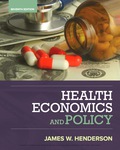
Subpart (a):
The preventive health care cost effectiveness.
Subpart (a):
Answer to Problem 3P
The total cost of 100 tests is $10,000. The total future medical expense averted is $15,000. The medical expense saved after setting up of the screening system is $5,000.
Explanation of Solution
The preventive health care measures are those medical precautionary measures which help the people to stay healthy and free from diseases. The screening system helps the people to easily identify and detect various diseases in their early stages which will help them to treat the diseases easily and affordably without much hassle.
The cost of one screening test is $100 according to the given information and the number of persons taking the screening test is 100. Thus, the total cost of taking the medical screening test can be calculated by multiplying the cost per screening test with the total number of persons taking the screening test as follows:
Thus, the total expense of 100 screening tests is $10,000.
The given percentage of persons having the test result positive is 15%. Thus, the total number of persons having positive test results can be calculated by multiplying the total number of persons with the given percentage as follows:
Thus, there will be 15 persons having the positive results from the screening test.
The amount of the future medical expense saved by the individual when the test result is positive is $1,000. Thus, the total future medical expense that can be saved by the people having the positive test results can be calculated by multiplying the per person medical expense saved with the total number of persons having positive test results as follows:
Thus, the total future medical expense saved by the persons having the positive test results is $15,000.
The cost of setting up the screening system is $10,000 and the total future medical expense saved is $15,000. Thus, the net future medical expense saved can be calculated by subtracting the cost of setting up the screening system from the total medical expense saved as follows:
Thus, the net medical expense saved after reducing the cost of setting up the screening test is $5,000.
Concept introduction:
Preventive health care: They are the measures taken in order to prevent the occurrence of a disease rather than treatment of a disease.
Sub part (b):
The net medical expense loss after reducing the cost of screening test.
Sub part (b):
Answer to Problem 3P
The total cost of 100 tests is $10,000. The total future medical expense averted is $5,000. The medical expense lost after setting up of the screening system is -$5,000.
Explanation of Solution
The cost of one screening test is $100 according to the given information and the number of persons taking the screening test is 100. Thus, the total cost of taking the medical screening test can be calculated by multiplying the cost per screening test with the total number of persons taking the screening test as follows:
Thus, the total expense for 100 screening tests is $10,000.
The given percentage of persons having the test result as positive is 5%. Thus, the total number of persons having positive test results can be calculated by multiplying the total number of persons with the given percentage as follows:
Thus, there will be 5 persons having the positive results from the screening test.
The amount of the future medical expense saved by the individual when the test result is positive is $1,000. Thus, the total future medical expense saved by the people having the positive test results can be calculated by multiplying the per person medical expense saved with the total number of persons having positive test results as follows:
Thus, the total future medical expense saved by the persons having the positive test results is $5,000.
The cost of setting up the screening system is $10,000 and the total future medical expense saved is $5,000. Thus, the net future medical expense saved can be calculated by subtracting the cost of setting up the screening system from the total medical expense saved as follows:
Since the result is having a negative sign, it shows that the expense of setting up the screening system is higher than the benefit received from the use of the screening system. Thus, the net result is a loss. Thus, the net medical expense loss after reducing the cost of setting up the screening test is -$5,000.
Want to see more full solutions like this?
Chapter 24 Solutions
Economics (Irwin Economics)
- In the graph at the right, the average variable cost is curve ☐. The average total cost is curve marginal cost is curve The C Cost per Unit ($) Per Unit Costs A 0 Output Quantity Barrow_forwardWhat are some of the question s that I can ask my economic teacher?arrow_forwardAnswer question 2 only.arrow_forward
- 1. A pension fund manager is considering three mutual funds. The first is a stock fund, the second is a long-term government and corporate fund, and the third is a (riskless) T-bill money market fund that yields a rate of 8%. The probability distributions of the risky funds have the following characteristics: Standard Deviation (%) Expected return (%) Stock fund (Rs) 20 30 Bond fund (RB) 12 15 The correlation between the fund returns is .10.arrow_forwardFrederick Jones operates a sole proprietorship business in Trinidad and Tobago. His gross annual revenue in 2023 was $2,000,000. He wants to register for VAT, but he is unsure of what VAT entails, the requirements for registration and what he needs to do to ensure that he is fully compliant with VAT regulations. Make reference to the Vat Act of Trinidad and Tobago and explain to Mr. Jones what VAT entails, the requirements for registration and the requirements to be fully compliant with VAT regulations.arrow_forwardCan you show me the answers for parts a and b? Thanks.arrow_forward
- What are the answers for parts a and b? Thanksarrow_forwardWhat are the answers for a,b,c,d? Are they supposed to be numerical answers or in terms of a variable?arrow_forwardSue is a sole proprietor of her own sewing business. Revenues are $150,000 per year and raw material (cloth, thread) costs are $130,000 per year. Sue pays herself a salary of $60,000 per year but gave up a job with a salary of $80,000 to run the business. ○ A. Her accounting profits are $0. Her economic profits are - $60,000. ○ B. Her accounting profits are $0. Her economic profits are - $40,000. ○ C. Her accounting profits are - $40,000. Her economic profits are - $60,000. ○ D. Her accounting profits are - $60,000. Her economic profits are -$40,000.arrow_forward
- Select a number that describes the type of firm organization indicated. Descriptions of Firm Organizations: 1. has one owner-manager who is personally responsible for all aspects of the business, including its debts 2. one type of partner takes part in managing the firm and is personally liable for the firm's actions and debts, and the other type of partner takes no part in the management of the firm and risks only the money that they have invested 3. owners are not personally responsible for anything that is done in the name of the firm 4. owned by the government but is usually under the direction of a more or less independent, state-appointed board 5. established with the explicit objective of providing goods or services but only in a manner that just covers its costs 6. has two or more joint owners, each of whom is personally responsible for all of the partnership's debts Type of Firm Organization a. limited partnership b. single proprietorship c. corporation Correct Numberarrow_forwardThe table below provides the total revenues and costs for a small landscaping company in a recent year. Total Revenues ($) 250,000 Total Costs ($) - wages and salaries 100,000 -risk-free return of 2% on owner's capital of $25,000 500 -interest on bank loan 1,000 - cost of supplies 27,000 - depreciation of capital equipment 8,000 - additional wages the owner could have earned in next best alternative 30,000 -risk premium of 4% on owner's capital of $25,000 1,000 The economic profits for this firm are ○ A. $83,000. B. $82,500. OC. $114,000. OD. $83,500. ○ E. $112,500.arrow_forwardOutput TFC ($) TVC ($) TC ($) (Q) 2 100 104 204 3 100 203 303 4 100 300 400 5 100 405 505 6 100 512 612 7 100 621 721 Given the information about short-run costs in the table above, we can conclude that the firm will minimize the average total cost of production when Q = (Round your response to the nearest whole number.)arrow_forward

 Exploring EconomicsEconomicsISBN:9781544336329Author:Robert L. SextonPublisher:SAGE Publications, Inc
Exploring EconomicsEconomicsISBN:9781544336329Author:Robert L. SextonPublisher:SAGE Publications, Inc Economics (MindTap Course List)EconomicsISBN:9781337617383Author:Roger A. ArnoldPublisher:Cengage Learning
Economics (MindTap Course List)EconomicsISBN:9781337617383Author:Roger A. ArnoldPublisher:Cengage Learning

 Principles of Economics 2eEconomicsISBN:9781947172364Author:Steven A. Greenlaw; David ShapiroPublisher:OpenStax
Principles of Economics 2eEconomicsISBN:9781947172364Author:Steven A. Greenlaw; David ShapiroPublisher:OpenStax





